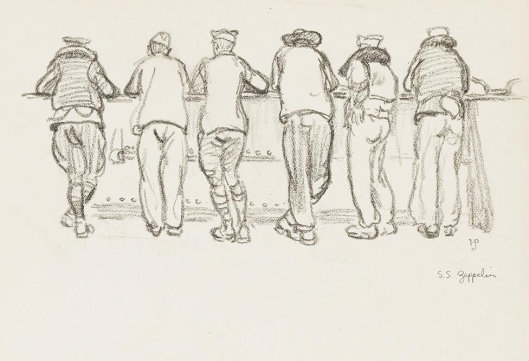In December 1928 Lovecraft wrote to his schoolteacher friend and correspondent Moe…
“I have come upon an altogether unsuspected country lane which winds up the ancient hill by the falls of the Moshafsuck … not a quarter of a mile from this very home [Barnes St.], yet which I never knew till this September. … line’d on one side by abandon’d gambrel-roof’d houses of the vintage of 1740 or 1750 … there is obtainable a glamourous view of Smith’s Hill — with the dome of the marble State House … which reminds one of the citadel of some fascinating Renaissance hill-town … it so overwhelm’d me with aestetick extasy when I first glimps’d it, that I was impelled to exclaim out loud, & whip forth my tatter’d note to make a crude sketch. … the [Providence] art club lately hous’d an exhibit which proves I am not alone in viewing Old Providence with an enraptur’d eye. The exhibit, of which I enclose a catalogue, was of drawings and etchings by one Henry J. Peck; and reveal’d the archaick liveliness of the ancient town [he] beholds the same cryptick overtones of brooding elder magick that I behold … huddles of ancient roofs, vistas of grass-grown colonial lanes & Georgian flights of railed steps, glimpses of tarry ghosts along the Indies-dreaming waterfront … the drawing reproduced in the catalogue is #30 of the exhibit — the antient inn-yard of the Franklin Tavern (circa 1770) on College Hill. … such arch’d yardways, when unlighted within, suggest the most spectral suggestions conceivable at night.”
Who was Peck, and where is this admired work now? Henry Jarvis Peck (1880-1964) was usually referred to by his contemporaries and editors as Henry J. Peck. He grew up and came of age in Warren, Rhode Island, attending the Rhode Island School of Design (RISD). He studied first with Eric Pape in Boston, then George L. Noyes, then from age 21 for three years with Howard Pyle.
A writer as well as an illustrative artist for books and magazines, his combined articles appeared for several decades in the more upmarket magazines of America. In the summer he lived in Warren with a studio at Rodney Street, but as the snow settled he went to overwinter in New York City. Warren, you’ll recall, was a favoured haunt of H.P. Lovecraft and the scene of some remarkable ice-cream eating contests.
A favourite creative approach seems to have been to charmingly contrast the traditional and the modern, with a New England twist.
He appears to have been working in his prime from around 1906-1929. Some surviving sketch material suggests he may have served as a rapid-sketch war-artist with the Navy. Here we see officers on deck.
By the mid 1920s some of his work for Scouting journals was quite cartoonish. He also painted a string of folk-art-y radio-ham magazine covers, with the same easy and warm approach.
He also produced more refined work in this cartoonish line, for the American Country Life magazine, as seen here in December 1928. One wonders if this was a one-off swan-song, or if there was a whole series of this material.
The online record suggests that Providence saw his only gallery show, and all that now remains are pictures in private hands. Lovecraft spoke to the artist at the launch of the show, and urged him to publish a book of the Providence work. But it was not to be. All that appears to survive is a catalogue for Glimpses of Providence, with a single picture, which is noted in the Moe letters. This is elsewhere noted as…
a small catalogue for an exhibition of drawings, “Glimpses of Providence and Vicinity,” by Henry J. Peck
The new Industrial Trust Building of 1928, looming over the old rooftops.
Lovecraft sent copies of the catalogue to Moe and Wandrei, and possibly to other correspondents. A label on a picture-back suggests Peck may once have had a studio in Providence in the 1920s, on Benefit Street, possibly while seeking out scenes and making the drawings for the 1928 show. But it seems he did not encounter Lovecraft before the big pre-Christmas 1928 show, and no contact was made afterwards.
Where is Peck’s body of work now, as indicated by the catalogue? Work which might be so useful now to illustrate “Lovecraft’s old Providence” of the 1920s, beyond the main well-known buildings and sights? Mostly sold and dispersed, by the look of it. One hopes that the finer etchings at least are ‘safely lost’, quietly folded away for posterity in some neglected archive. But no such online record page seems to exist for such a holding, and a search of the RISD archives database also suggests nothing. But one such recently came up for the auction, going for a pitiful $30, and the auctioneers kindly left a large scan online.
“Down College Street” (1928). A familiar-seeming man climbs the hill with a book or bundle of letters.
Toward the end of his life Peck did produce a book, a history of his home town of Warren in the form of 200th Anniversary of Warren, Rhode Island. Historical Sketch and Program 1747-1947.




















Looking at plate 22-3a (plate 22 scan 7) of the 1918 Providence Atlas, I am led to believe that Lovecraft may be referring (in his 1928 letter to Moe) to Halsey Street, which does take a bit of a bend at Pratt Street. The “falls of the Moshassuck” are I believe at approximately where Mill Street (running from North Main to Charles) crosses the Moshassuck. Neither Jenckes nor Star (among other possible candidates) seems to take any significant bend.